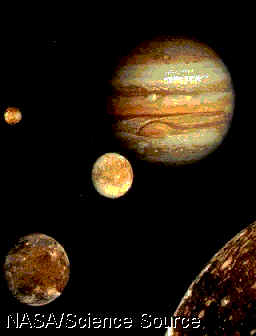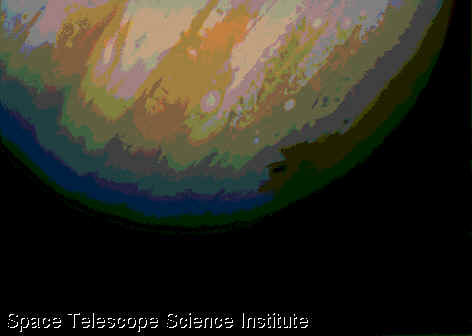|
|
|

Once every 11.9 Earth years Jupiter makes a complete orbit around the sun at a mean distance 5.2 times greater than that of Earth, but it takes Jupiter only 9.9 hours to rotate once on its axis. This rapid rotation causes a bulge at Jupiter's equator that is apparent in telescopic views of the planet. The rotation is not uniform. Jupiter's colorful bands are caused by strong atmospheric currents (see Atmosphere) that lead to different rotation periods at different latitudes. These bands are made more apparent by the pastel colors of Jupiter's clouds, including the famous rust-colored oval called the Great Red Spot. The colors come from traces of chemical compounds formed by ultraviolet light, lightning discharges, and heat. Some of these compounds may be related to organic molecules that formed on the ancient earth as a prelude to the origin of life (see Exobiology).

*(Cornet Bombardment of Jupiter, 1994)*
Jupiter's Satellites and Rings
Sixteen satellites of Jupiter have so far been discovered. The four largest were discovered in 1610 by Italian astronomer Galileo. They were subsequently named after mythological love partners of Jupiter: Io, Europa, Ganymede, and Callisto. This tradition has been followed in the naming of the other moons. Modern observations have shown that the mean densities of the largest moons follow the trend apparent in the solar system itself. Io and Europa, close to Jupiter, are dense and rocky like the inner planets. Ganymede and Callisto, at greater distances, are composed largely of water ice and have low densities. During the formation of planets and satellites, closeness to the central body (the sun or Jupiter) evidently prevented substances that easily evaporate from condensing.
Callisto is almost as big as Mercury, and Ganymede is bigger than Mercury. If these satellites orbited the sun, they would be considered planets. The icy crusts of these two bodies are marked by numerous craters, the record of an early bombardment, probably by comet nuclei, similar to the asteroidal (see Asteroid) battering that scarred earth's moon. In contrast, the surface of Europa is extremely smooth. It is covered by a layer of water ice that emerged from Europa's interior after the early bombardment, and a layer of liquid water may lie beneath the ice. An intricate network of shallow cracks covers the icy surface. Observations conducted by the Hubble Space Telescope in June 1994 detected a thin oxygen atmosphere on Europa, making Europa the fourth moon in the solar system known to have an atmosphere.
The most remarkable satellite is unquestionably Io. Its surface has a bizarre appearance: yellowish, brown, and white areas dotted by black features. Io is racked by volcanism that is driven by the dissipation of tidal energy in this satellite's interior. Ten volcanoes were erupting during the Voyager flybys in 1979, and evidence for later eruptions has since been detected. Sulfur dioxide issues from the vents and condenses on the surface, forming a local, transient atmosphere. The white regions are solid sulfur dioxide; the other markings are presumably caused by other sulfur compounds.
The remaining moons are very much smaller and less well studied than the four Galilean satellites. Between Jupiter and Io are the moons Metis, Adrastea, Amalthea, and Thebe. Away from Jupiter, past Callisto, are eight more moons, arranged in two clusters of four moons each, which may be bodies that have been catured by Jupiter's gravity. The inner cluster is made up of Leda, Himalia, Lysithea, and Elara; the outer cluster contains Ananke, Carma, Pasiphae, and Sinope.
Close to the planet, the Voyager spacecraft discovered a faint system of rings. The material in these rings must be continuously renewed since it is visibly moving in toward the planet. It may be produced by the disintegration of small moonlets imbedded within it. The satellite Metis is just at the outer boundary and could be one source of ring material.

*(Great Red Spot)*

For more information on Jupiter, Please visit the following websites:

[Hit Counter]
